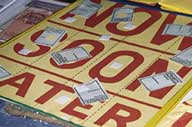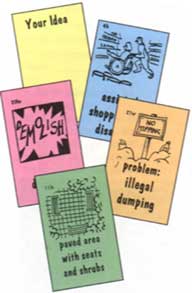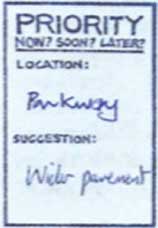Community Planning: Methods
Planning for Real
- description
- more detail
- more pictures
Planning for Real uses simple models as a focus for people to put forward and prioritise ideas
on how their area can be improved. It is a highly visible, hands-on community development and empowerment tool, which people of all abilities and backgrounds find easy and enjoyable to engage in.
on how their area can be improved. It is a highly visible, hands-on community development and empowerment tool, which people of all abilities and backgrounds find easy and enjoyable to engage in.
A large 3-dimensional model of a neighbourhood is constructed, preferably by local people, using cardboard cut-outs for buildings pasted onto a base plan fixed to polystyrene or cardboard.
The model is used at pre-advertised sessions held in various locations in the community.
Participants place suggestion cards on the model indicating what they want to see happen and where (eg playground, parking, standpipe, tree, shopping).
The cards are sorted and prioritised to establish an action plan which is followed up by working groups.
Photocredits
top: Queens Park, Bedford, UK, 1995, unknown.
bottom: London, UK, 1997, Nick Wates.
top: Queens Park, Bedford, UK, 1995, unknown.
bottom: London, UK, 1997, Nick Wates.

Making suggestions
Participants mill around the model, and make their views known by placing pre-written or self-completed suggestion cards onto it.

Prioritising
Working in small groups, participants order the suggestions by placing cards onto a chart which is divided into three bands 'Now', 'Soon', 'Later' on one axis and those who should be responsible for taking action on the other.
Tips
- Kits with building cut-outs and cards can be purchased (see further info), or you can make up your own using available materials.
- Events work best if facilitated by someone who has done it before but the basic idea is easy to pick up from the kits. The kits' manufacturers the Neighbourhood Initiatives Foundation recommends that users should be fully trained by them.
- The model kits are good for generating interest and creating an initial vision. After that they need some creative adaptation if they are to be used for detailed design.
Costs
- From US$800 (venue and materials) to $24,000 (trained facilitator to prepare for several months).
Typical Planning for Real process
- Initiation. Define area. Set up Steering Group. Get support. Purchase model pack (optional) or gather materials. (3 months)
- Make model. A collective exercise by Steering Group, often with school children or students. Usually to a scale of 1:200 or 1:300 which allows people to identify their own homes and in sections so that it is easily transportable. (2 days)
- Publicise activity. Take model around the area to generate interest.
(2 weeks) - Training session. Run through process with Steering Group.
(2 hours) - Open sessions. One or more times in different locations.
- People gather around model. Introduction by facilitator explaining objectives and process. (10 mins)
- Participants individually place suggestion cards on the model. Professionals watch and answer questions but do not take part. (30 mins) Participants discuss results and rearrange cards until collectively happy with the result. (30 mins)
- Participants record results, usually on priority cards setting out the suggestion and its location. (30 mins)
- Participants prioritise suggestions by placing priority cards on Now, Soon or Later boards and identifying who should take action. (30 mins)
- Discussion on next steps and establishing working parties on the main issues. (20 mins)
- Working parties. Follow up suggestions. (2 months)
- Feedback. Circulation of newsletter. (1 month)
Inspiration
-
"Compromise and consensus become easier because everyone's line of vision converges on the subject matter the model itself allowing for practical ways of non-threatening communication and participation."

Suggestion cards
These can be prepared with blanks for people to add any ideas of their own. The use of colour and visual symbols makes the process accessible to those with low literacy skills

Priority cards
These are used to record all suggestions and their location
Thanks: Margaret Wilkinson. Planning for Real® is a registered trademark of the Neighbourhood Initiatives Foundation